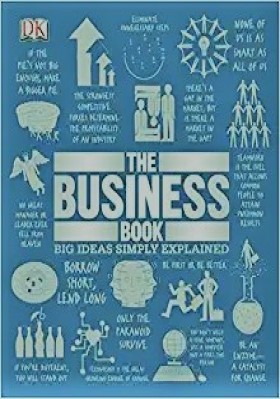
| The Business Book Big Ideas |
| D. K |
| 354 |
| 38.7 Mb |
| |
| PDF Direct Download Link |
| Click for Hard Copy from Amazon |
The Business Book (Big Ideas) – Book Sample
Introduction – The Business Book (Big Ideas)
From the time that goods and services began to be traded in early civilizations, people have been thinking about business. The emergence of specialized producers and the use of money as a means of exchange were methods by which individuals and societies could, in modern terms, gain a “business edge.”
The ancient Egyptians, the Mayans, the Greeks, and the Romans all knew that wealth creation through the mechanism of commerce was fundamental to the acquisition of power, and formed the base on which civilization could prosper.
The lessons of the early traders resonate even today. Specialism revealed the benefits of economies of scale—that production costs fall as more items are produced. Money gave rise to the concept of “value added”—selling an item for more than it cost to produce.
Even when barter was the norm, producers still knew it was advantageous to lower costs and raise the value of goods. Today’s companies may use different technologies and trade on a global scale, but the essence of business has changed little in millennia.
An era of change – The Business Book (Big Ideas)
However, the study of business as an activity in its own right emerged relatively recently. The terms “manager” and “management” did not appear in the English language until the late 16th century. In his 1977 text The Visible Hand, Dr. Alfred Chandler divided business history into two periods: pre-1850 and post-1850. Before 1850 local, family-owned firms dominated the business environment.
With commerce operating on a relatively small scale, little thought was given to the wider disciplines of business. The growth of the railroads in the mid-1800s, followed by the Industrial Revolution, enabled businesses to grow beyond the immediate gaze of friends or family, and outside the immediate locale.
To prosper in this new—and increasingly international— environment businesses needed different, and more rigorous, processes and structures.
The geographic scope and ever-growing size of these evolving businesses required new levels of coordination and communication—in short, businesses needed management.
Managing production
The initial focus of the new breed of manager was on production. As manufacturing moved from individual craftsmen to machinery, and as ever-greater scale was required, theorists such as Henri Fayol examined ever-more-efficient ways of operating.
The theories of Scientific Management, chiefly formulated by Frederick Taylor, suggested that there was “one best way” to perform a task. Businesses were organized by precise routines, and the role of the worker was simply to supervise and “feed” machinery, as though they were part of it.
With the advent of production lines in the early 1900s, business was characterized by standardization and mass production.
While Henry Ford’s Model T car is seen as a major accomplishment of industrialization, Ford also remarked “why is it every time I ask for a pair of hands, they come with a brain attached?” Output may have increased, but so too did conflict between management and staff. Working conditions were poor and businesses ignored the sociological context of work—productivity mattered more than people.
Studying people – The Business Book (Big Ideas)
In the 1920s a new influence on business thinking emerged—the Human Relations Movement of behavioral studies. Through the work of psychologists Elton Mayo and Abraham Maslow, businesses began to recognize the value of human relations.
Workers were no longer seen as simply “cogs in the machine,” but as individuals with unique needs. Managers still focused on efficiency, but realized that workers were more productive when their social and emotional needs were taken care of. For the first time, job design, workplace environments, teamwork, remuneration, and nonfinancial benefits were all considered important to staff motivation. In the period following World War II, business practice shifted again.
Wartime innovation had yielded significant technological advances that could be applied to commerce. Managers began to utilize quantitative analysis, and were able to make use of computers to help solve operational problems. Human relations were not forgotten, but in management thinking, measurability returned to the fore.
Global brands
The postwar period saw the growth of multinationals and conglomerates—businesses with multiple and diverse interests across the globe.
The war had made the world seem smaller, and had paved the way for the global brand. These newly emerging global brands grew as a result of a media revolution—television, magazines, and newspapers gave businesses the means to reach a mass audience.
Businesses had always used advertising to inform customers about products and to persuade them to buy, but mass media provided the platform for a new, and much broader, field— marketing. In the 1940s US advertising executive Rosser Reeves promoted the value of a Unique Selling Proposition. By the 1960s, marketing methods had shifted from simply telling customers about products to listening to what customers wanted, and adapting products and services to suit that. Initially, marketing had its critics.
In the early 1960s hype about the product became more important than quality, and customers grew dissatisfied with empty claims. This, and competition from Japanese manufacturers, had Western companies embracing a new form of business thinking: Total Quality Management (TQM) and Zero Defects management.
Guided by management theorists, such as W. Edwards Demming and Philip B. Crosby, quality was seen as the responsibility of the entire company, not just those on the production line. Combining Human Relations thinking and the customer-focused approach of marketing, many companies
The art of administration
is as old as the human race.
Edward D. Jones
US investment banker (1893–1982)
To read more about the The Business Book Big Ideas book Click the download button below to get it for free
or
 Don't Miss out any Book Click Join OpenMaktaba Telegram group
Don't Miss out any Book Click Join OpenMaktaba Telegram group